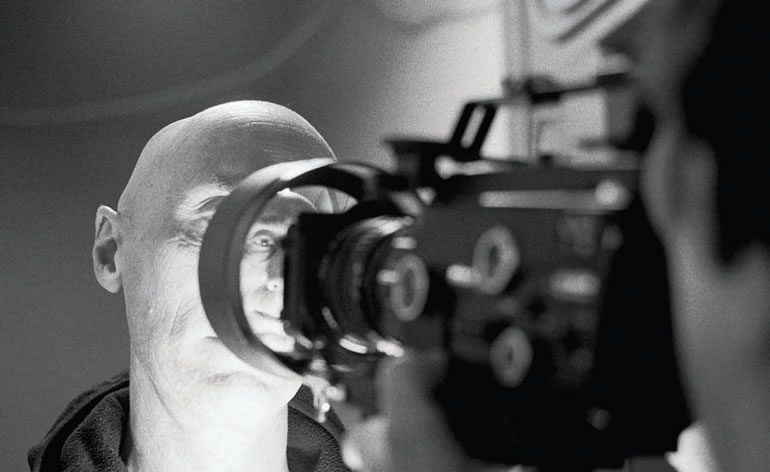“Sometimes, someone can give you a helpful note, like in the case of ‘Back to the Future’, changing a refrigerator to a car.”
How to Get the Most Out of a Notes Meeting
Written by Matt Koss
It might have taken a year.
You’ve come up with a solid idea, formulated a logline, and worked through a complete synopsis of your feature or tv pilot. You’ve mapped out your characters, elaborated on their arcs, and now, with a completed first draft, you’re ready to have some fresh eyes on your script.
A notes meeting can be incredibly daunting, and the notes may come in many shapes and sizes. The reasons for the notes might be because an executive is interested in your screenplay, it’s a potential representation meeting, you’ve decided to have a script consultation through an independent company, or they may even come in the form of feedback from screenwriting competitions.
What’s most important to remember is that each reader will come into your story from their perspective, formulated from their own experience. How someone views your screenplay is purely a perspective outside your own, for better or worse.
But how do you get the most out of a notes meeting? What are the types of things you should be looking for, and how can you best conduct yourself to remain open to opinions?
This article will look at ten different vital areas to consider when preparing for a notes call or meeting, no matter who the person is sitting in front of you, on zoom, or over the phone.
#1. A notes call does not diminish your hard work.
Whether the person giving the notes has a positive or negative outlook on your screenplay, each note can offer a new approach to your script. One thing is sure: no matter the direction of the notes, you have accomplished an incredible feat by completing your current screenplay. Not everyone can sit and write what’s in their head, nor may they have the drive and opportunity to receive notes from someone, whether it’s a person working in the industry or even a family or friend.
Notes can often be overwhelming, but the most important thing to remember is that you have put in the hard work. The notes you receive are only shared with you to help shape your current draft into something appealing, emotionally compelling, and commercial/sellable.
#2. Always remember to thank the reader.
As you continue pushing your script through screenwriting competitions and archival platforms like The Blcklist or InkTip, the reader has put in the effort to find your script and read it.
To put it into perspective, a Creative Executive, Producer, Executive, or Director are frequently reading with little time to spare. When I worked for Zero Gravity Management as a Creative Executive, I would read between 7 to 10 scripts a week amongst other work and meetings.
When you hop on the call, zoom, or eventually an in-person meeting, remember to appreciate the time and effort that person has spent reading your script and writing out notes to discuss with you. Their only objective is to help you with your script and mold it into something they can either sell, acquire or represent.
#3. Divide your notes during the meeting into subsections to help understand, and make sense of, what was discussed.
Notes come in all shapes and sizes. A former colleague once sent thirty pages of notes to a writer for a sixty-minute pilot! Indeed, notes can be overwhelming, and the person giving them may not always have the most structured way to present the notes.
Whether you’ve received the notes in writing or having a conversation with the person, you can immediately begin to sort the notes by sections to understand their scope and how best to integrate them.
As you’re having the discussion, you should take notes to ensure you remember all the key points brought up. Dividing your notes into sections or subcategories can help structure the feedback. Those thirty pages of notes my colleague sent out? Well, even I had a lot of trouble connecting all the threads. Further, in conversations, the notes’ direction can shift quickly from character to pacing to tone.
To maintain control of your own notes within the discussion and how you interpret the notes afterward, here are some tips for differentiating each note by section:
P – Plot
- Does the note have to do with the overall plot?
- Is the note looking at a particular plot point?
C – Character
- How does the note relate to the character?
- Is the note referencing a character trait?
- Is the reader finding it challenging to access the character’s personality/decision-making?
D – Dialogue
- Is your character’s voice individualized?
- Are the notes indicating something your character says that may be working/not working?
- What is the line of dialogue the note is referring to?
S – Structure
- Is the structure working?
- Is the note alluding to reshaping the structure of the story to heighten dramatic moments?
- Does the three-act structure work for your project? Or, if it’s a TV pilot, are the act breaks working?
TP – Tone & Pacing
- Are the notes talking about the momentum of the script?
- Do the notes refer to tonally confusing moments or scenes that affect pacing?
S – Setting
- What is working about the set-up of the overall world?
- How is the world integrated into the script?
- Is there a passage of time, or how do we know time has passed?
V – Voice
- How is your voice maintained for you as a writer?
- What are the unique aspects of your script that highlight/diminish your voice?
* Use the shorthand lettering next to your notes to indicate which section the note you’re receiving falls into.
#4. A story note vs. personal expectation and preference.
Oh, this is a doozy.
With my work as a career coach and screenwriting consultant with Roadmap Writers, there is one thing that I always tell writers: Know the difference between someone giving you a note and someone trying to reshape your story into their image of what your story should be.
Sometimes, someone can give you a helpful note, like in the case of Back to the Future, changing a refrigerator to a car. But at the end of the day, this is your idea, your vision, and the hope is that the person giving the note is only trying to elevate your story, not what they think your story should be instead.
So, what is the difference between someone giving a note and someone trying to reshape your story into their idealized version of what your script should be?
Example: In your script, a hurricane has left a town depleted. The locals are struggling to get back on their feet, and your protagonist, a policewoman, has found someone murdered. It’s undetermined if they died during the hurricane or the natural disaster uncovered the murder.
A useful note here might be how the policewoman relates to the murder. Perhaps it is someone she knows, or she may be involved in the murder. This note can help build character dynamics and add momentum to the story. If this is a TV show, it can become a central mystery for a season-long arc or answer a question about a particular shady local that the policewoman has met.
A note where someone is using their own vision may be that perhaps there is a little boy in town who, after the hurricane, discovers that he has healing powers. Maybe he comes and helps revive the dead body so the policewoman can find out more information about the murder. This would be an example of someone thinking outside of your story’s world and trying to add a mystical element, perhaps to satisfy the criteria for types of stories they’re looking to develop.
Of course, notes come in various shapes and forms. What is currently popular on TV may inspire the note giver to provide notes that appeal to a particular demographic based on current trends. But there is a difference between using your voice as the writer of the story and reshaping your voice.
Take the notes as you like. You may decide that the little boy with healing powers is an exciting direction. But when you’re thinking about your pilot’s different aspects, how does it fit into the larger picture?
#5. Write a new draft. DO NOT forget to save your previous version!
Not all drafts of your script will be perfect. Not all notes are conducive to making a script better. Not all ideas are going to inform a character’s journey and overall arc in the story.
That last version of your script before you apply the notes from an executive? Don’t lose that draft!
What might work for one executive may not work for another. That previous draft can be your template to try new things, so you never want to save over it without having a previous version saved.
There will be many versions of your script, so save each one!
#6. Ask Questions.
I preface a consultation with writer’s that I don’t want to be giving a monologue for an hour. You, as the writer, will not always agree with my notes. Therefore, let’s discuss it!
Notes can and should be a conversation.
If someone has put in the time and effort to read your script and sit down with you to give you notes, then have a conversation about it. You’ll be so surprised by what can be revealed during these notes meetings if you talk it out with someone who has invested time in your script.
#7. Objectivity is beautiful.
Each reader will come to your script from their view of the world. We are all shaped by our experiences and appreciate art based on our individuality.
I am terrified of horror films. I cannot sit alone and watch a horror movie or TV show without someone next to me. I can’t even get past the first episode of American Horror Story, Season 2 without muting the scarier scenes. But when I read a horror script, I can identify the scares and character moments, and world-building. The value I bring is from the perspective of outside the key demographic.
Our backgrounds, how we grew up, the school we went to, our friends, our family all inform our thought processes. Your script may fall into the hands of three executives with different backgrounds. They may find common areas in their notes and may differ in reactions to character moments.
Find consistency and where the consensus is differing. Each viewpoint can be valid, and it’s objectivity that makes perspective unique.
#8. You are allowed to disagree with the notes giver.
Recently, I was working with a group of writers in a multi-week course where, upon reading a one-hour pilot from a writer, my suggestion was to change it to a 30-minute concept. We discussed the format change, and the writer seemed to be hesitant but wouldn’t give a reason. I encouraged her to open the discussion and explain the hesitation, and together, we concluded that if she could map out the 30-minute version and it seemed more viable, then it’s something to explore.
I was so appreciative of her hesitation. This pilot was her baby! She’s an acclaimed author with years of experience. Who was I to tell her what her story should be?
Because we could have the conversation together, talk through the changes that would take place, and condense key story elements for a tighter structure and pacing, she ended up writing a new, fantastic 30-minute pilot that worked.
Disagreement is natural, and it is also helpful. It encourages discussion and contemplation. If you disagree with the notes giver, discuss their reasoning and how you can see the thought formulation behind their note. You may not want to change your pilot, but the conversation can illuminate another note behind the note.
#9. The note behind the note.
Not every note is going to be exact. It will take some meditation, conversation, and perhaps some distance from your script to absorb its meaning. You may wake up at 3AM and have an ‘a-ha’ moment where you understand what the note giver was trying to say. There was undoubtedly something worth using for my former colleague with thirty pages of notes, but it required severe dissection to figure it out.
Sometimes, the critical note you’ll receive is what hides behind the note.
Example: A man walks into a bank to find that the building is under a hostage situation. The man walks back out the door and slinks away down the street before cutting back to the interior where the hostage situation is taking place.
A note here could be that the man is exterior to the story and not useful in pushing forward the plot. He isn’t helping any of the characters or adding dimension to the situation. Why is there a man at all if he isn’t driving the story forward?
So, what could the note here be behind the note?
Well, perhaps it’s just not believable that during a hostage situation, a man could calmly enter the building and walk away. Perhaps, the note behind the note is that to see the brutality of the criminals involved; maybe they should apprehend and beat the man instead. This would indicate more about the criminals’ personalities and add a note of danger and escalating tension. Another note behind the note is the man may have already been a hostage but manages to escape and calls the police. That would make him useful in the script and add more stakes for the people inside the building.
The clarity of a note is in its interpretation.
#10. The art of networking.
Networking is often like a first date. It can be a deluge of superficial information that adds little value to your intentions as a writer.
When you’re meeting with a notes giver, be it a consultant, potential representative, or an executive interested in discussing your script, each connection is an opportunity.
Don’t forget to follow-up to thank the person and send your latest draft for their perusal. It’s also crucial that the people you meet are not just a title but a human being. Try to connect on some level. Perhaps they’re interested in your romantic comedy about two friends falling in love because they love watching light comedies like No Strings Attached. Ask what appeals to them about the film and also what movies inspired you to write your screenplay.
A connection is most useful when you can relate on a human level. Doing your research on the person can help immensely, and maintaining that contact can lead to opportunity.
Matt Koss
Originally from Melbourne, Australia, Matt has worked with companies such as Zero Gravity Management (OZARK; THE ACCOUNTANT), MGMT Entertainment and Sundance Institute. He appeared on the Final Draft Big Break Screenwriting Podcast WRITE ON.
Website: thewanderingscreen.com
LinkedIn: linkedin.com/in/matthew-koss-7068b9b6
Instagram: instagram.com/thewanderingscreen





